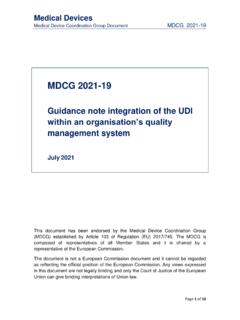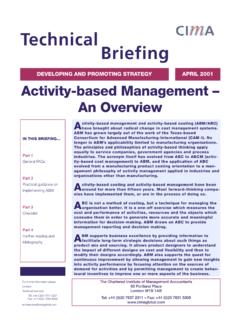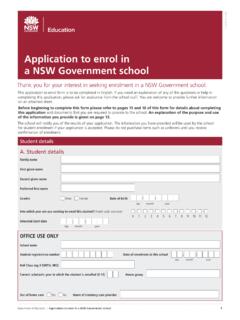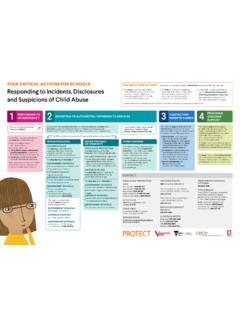Transcription of 05.1E MITIGATING CIRCUMSTANCES PROCEDURE
1 MITIGATING CIRCUMSTANCES . PROCEDURE . Academic Handbook 2021/22 Volume 1 MITIGATING CIRCUMSTANCES PROCEDURE new version introduced ;. modified , , , ; last modified 1. Cardiff Metropolitan University MITIGATING CIRCUMSTANCES PROCEDURE Introduction 1. MITIGATING CIRCUMSTANCES , often called Exceptional Personal CIRCUMSTANCES or requests for additional consideration, are significant changes in a candidate's CIRCUMSTANCES during their studies, which are outside the control of the candidate, and which the candidate believes have adversely affected their academic performance on one or more assessment. 2. Students are encouraged to work with their Personal Tutor/Year Tutor as soon as difficulties are foreseen or occur, in order to attempt to prevent those difficulties from adversely affecting the student's academic performance, and reduce the need to submit a MITIGATING CIRCUMSTANCES Application.
2 3. Students with a disability or chronic illness should contact The University's Student Wellbeing Team to make special arrangements for learning and assessments, such as extra time allowance. Nature of MITIGATING CIRCUMSTANCES 4. It is not possible to provide a definitive list of all possible MITIGATING CIRCUMSTANCES , but for example claims might be on the basis of: a. illness of the candidate b. illness of a partner/spouse, close family member or close friend c. bereavement d. accident e. court appearance or jury service. 5. A disability or chronic illness does not constitute exceptional personal CIRCUMSTANCES ' unless there is medical evidence of a sudden and unforeseen deterioration or a particularly severe episode. 6. The usual financial difficulties experienced by most students do not constitute MITIGATING CIRCUMSTANCES , unless there has been a sudden and unforeseen change in financial CIRCUMSTANCES , such as the loss of a job or death of a sponsor.
3 7. The usual professional commitments or employment demands do not constitute MITIGATING CIRCUMSTANCES , unless there is evidence from an employer that commitments and demands have been exceptionally substantial and temporary. Academic Handbook 2021/22 Volume 1 MITIGATING CIRCUMSTANCES PROCEDURE new version introduced ;. modified , , , ; last modified 2. 8. The loss of material due to failure or theft of a computer or ancillary device thereof ( pen drive or printer) does not normally constitute MITIGATING CIRCUMSTANCES , as students are required to back up their work. 9. Students participating in elite sport must contact the Sport Performance Director to make arrangements to manage their academic commitments and should not apply for MITIGATING CIRCUMSTANCES related to their sporting participation.
4 Self-Certified Extension 10. Twice per academic year (once per term/semester), all students may apply for an extension to their assessment deadline for any reason, and without providing evidence (self-certification), provided the following are met: (i) The request is submitted before the assessment submission deadline or in-class test. Requests submitted not later than one minute before the deadline will be accepted. (ii) The request is made through the correct portal. (iii) The student clearly identifies the assessment(s) for which they are requesting self-certification. (iv) The submission dates for all requested assignments or in-class tests fall within five working days (not inclusive of the day of submission) of the day of submission. (v) The requested assignments do not include any formal examinations (which are exempt from the self-certification provision).
5 11. Requests for self-certification will be reviewed by School Administration teams who will, provided the application meets the above criteria: - extend the submission date in Moodle for all assignments by ten working days*;. - ensure that the student, module leader and any other relevant staff are advised of the deadline extension(s);. - ensure that the relevant information is made available to Examination Boards. *For some forms of assessment ( presentation or in-class test), it may be advantageous for the assessment to be rescheduled sooner than ten working days; in such cases, this will be confirmed in negotiation with the relevant module leader. 12. If a student is unable to complete the assignment within the revised deadline, they will be required to submit a full MITIGATING CIRCUMSTANCES application, with supporting evidence, for a Non-Attempt or a Late Submission deadline.
6 Academic Handbook 2021/22 Volume 1 MITIGATING CIRCUMSTANCES PROCEDURE new version introduced ;. modified , , , ; last modified 3. 13. All other MITIGATING CIRCUMSTANCES applications, either for late submission made after the assignment deadline, or for non-attempt at an assignment, must be supported by third-party evidence. (see 18). 14. As it is in the interests of students to complete assignments, wherever possible, at the first attempt, students are required to apply for a Late Submission in the first instance. 15. If a student genuinely believes that they will not be able to complete their work at the first attempt, even with a late submission, they should speak with their Programme Director to discuss an appropriate way forward; this may include being permitted to apply directly for a non-attempt, with appropriate supporting evidence.
7 Submission of MITIGATING CIRCUMSTANCES Applications 16. The MITIGATING CIRCUMSTANCES Application and supporting evidence must be submitted to the relevant MITIGATING CIRCUMSTANCES Committee in accordance with instructions in the relevant Programme Handbook. It is a student's responsibility to submit their own application. 17. Applications must be submitted: a. within 20 working days prior to the date of submission, (this includes the new date of submission from any agreed SC extension-subject to the exception in c. below). or b. within 20 working days following the date of submission, (this includes the new date of submission from any agreed SC extension-subject to the exception in c. below). or c. before the relevant Examination Board, in the event that the Examination Board falls sooner than 20 working days following the date of submission.
8 18. MITIGATING CIRCUMSTANCES Applications that fall outside the timescales in 17a- 17c above will not be considered. Therefore, the student must invoke the Appeals PROCEDURE (Exam Board Decisions). You can access the up to date Examination Board timetable here: Acceptable Evidence of MITIGATING CIRCUMSTANCES 19. It is not possible to provide a definitive list of all acceptable supporting evidence, but the following are typical examples of evidence that would be acceptable: Academic Handbook 2021/22 Volume 1 MITIGATING CIRCUMSTANCES PROCEDURE new version introduced ;. modified , , , ; last modified 4. a. a Medical Certificate obtained at the time of the illness b. a signed and dated letter from a medical practitioner confirming the illness of the candidate or other person (this must include dates covered by the illness).
9 C. copy of Death Certificate d. copy of Birth Certificate e. a signed and dated letter or email from the candidate's employer f. a signed and dated letter or email from a coroner, legal practitioner, police officer, court official, minister of religion or other professional. g. All letters and emails must either be on the official headed notepaper of the individual or organisation concerned or sent from the official email address. 20. If a student does not consult a medical practitioner at the time of the illness, it is not acceptable for a student to attempt to obtain corroborative medical evidence at a later date. A letter from a medical practitioner stating, for example, the student informs me that he/she was unwell during . will not be deemed acceptable supporting evidence. 21. A photograph or photocopy of medication prescribed by a medical practitioner (without having seen the student or other individual in person), will be deemed acceptable supporting evidence, providing that the date is in line with the period for which MITIGATING CIRCUMSTANCES are requested, and the name of the individual, identity of the medication, and identity of the issuing pharmacy are clearly visible.
10 22. In CIRCUMSTANCES where the above are not available, students should consult the Students' Union or their Programme Director before submitting the MITIGATING CIRCUMSTANCES Application, as alternative forms of evidence may be acceptable. 23. Where the supporting evidence relates to a third party with a different family name from the candidate, the candidate should explain their relationship to the third party. Consideration of MITIGATING CIRCUMSTANCES 24. If MITIGATING CIRCUMSTANCES Applications are submitted at times when the MITIGATING CIRCUMSTANCES Committee is not scheduled to meet, its Chair shall be empowered to have discretion to take decisions on behalf of the Committee, taking advice from other members of the Committee if appropriate. All decisions taken by the Chair shall come before the next meeting of the Committee for ratification.










